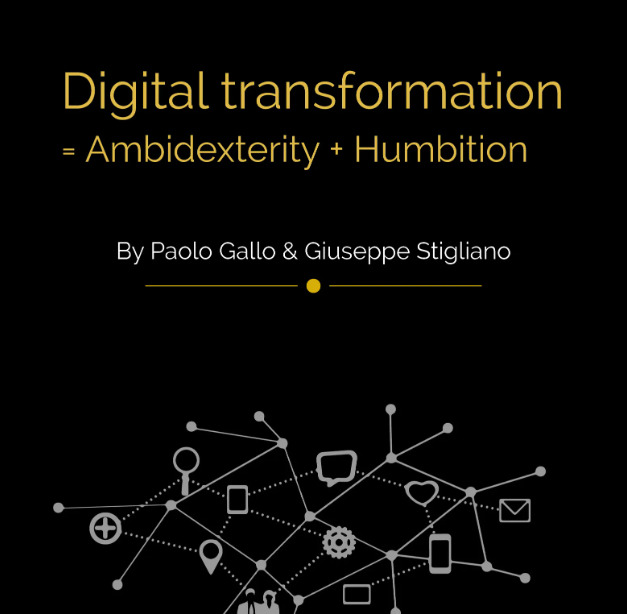
If we had received one Dollar every time we have listen or read “digital transformation” we would drive a Ferrari. In fact we can get more than a billion results by searching it on Google: we cannot claim we have read them all of course, we have noticed how little emphasis is devoted to the role and the mindset of Leadership in understanding and shaping Digital transformation.
Shall we give it a try?
A lot of what we have learned at business school and at work over the last 30 years is obsolete, incomplete, or simply wrong. The context is more than ever volatile, uncertain, complex, and ambiguous (VUCA), space and time have been permanently redefined. TThere are more smartphones than there are toilets, new firms will replace 75% of the S&P 500 firms by 2027 and the art of scenario planning seems to be guesswork more than strategy. Even before Covid-19 we were in the middle of a paradigm shift. Most established companies were going through some form of digital transformation, in order to avoid being disrupted by new hungry and aggressive digital native competitors. Now that the flood wave of the pandemic has passed and the situation appears relatively under control, we are realising that the urgency for established companies to embrace a real digital transformation is even more pressing.
A seasoned executive we have been working for, recently said to us, “I have always been suspicious of those who say that they know what the future will look like. But this time, it is crystal clear that either we adapt or die”. The problem is adapting to what and how. We have learned that there is a crucial concept to be metabolised – in the last few decades our world went from being complicated to being complex. And it is paramount for leaders and managers to understand the difference between the two. If you treat a complex matter as a complicated one, you are doomed to fail. Once decoded, complicated matters are highly predictable, while complex systems are the complete opposite. When something is complicated, even in presence of a high degree of difficulty, we can segregate and analyse all the variables, experiment with multiple trials and errors, determine the best sequence or combination of components, and finally establish a repeatable process which will guarantee a fairly similar outcome in the future. When we face a complex scenario, instead, we need to accept the fact that certain things are not equivalent to the sum of their parts, just because the variables at play interact in unpredictable ways. Every time we face something unknown for the first time, we tend to label it as complex. In some cases, though, establishing a clear process is simply impossible. This is the case of a complex context. Every time that the role of human beings is predominant, we face a de facto complex issue, as people tend to behave in virtually infinite ways.
This is the situation we typically deal with when we acquire and integrate a start-up into an established large organisation, or when we try to rebuild momentum after a turnaround. Of course, managers and leaders can rely on their experiences and try to apply consolidated processes and procedures, but they should accept that in these cases they are entering an unexplored path with potentially unpredictable results. And guess what? Even if they are lucky and smart, and they succeed in figuring out how to make it work, they should acknowledge that it is impossible to infer a bullet-proof playbook for the next time when facing a complex matter. In such a scenario, one size doesn’t fit all, and we can’t determine what is right for companies based on best practices, simply because the variables in the equation tend to constantly change, and today they do it at the speed of an algorithm.
However, this doesn’t mean that we have the luxury to wait and see. Instead, we should develop the adaptability muscle and embrace experimentation. We also need to be mindful that experiments are by their nature prone to failure, but a single success can compensate for many things that didn’t give the desired result.
When we discuss this topic with business leaders, we quite often receive the question – even when we acknowledge that the world is complex, how can we become nimbler, adaptive, keen to trial-and- error, to accept failure and to follow unexplored paths if our organisations are still structured to measure and incentivise traditional KPIs? We think this is the essence of digital transformation. It’s people who make companies. Organizational culture is a reflection of its leaders culture, mindset, ethics and consciousness as any transformation is first and foremost a cultural shift. Digital technology is an enabler, a means to an end, but it isn’t the essence of the shift. The more leaders internalize and understand that a brand new model is needed, the more they can increase the chances to ignite a real transformation, even within large established organization; the virtues of experience with intellectual honesty, builds with the past in a constructive, open and unbiased way. We don’t want to be naive; we know that companies are not in the business of avoiding risks uncertainty, change and experimentation. On the contrary they prosper in a stable context. And yes, analytical problem solving, crisp decision-making, the articulation of clear direction is still very relevant skills for leaders.
So how can we be two faced? How can we look backwards enough to leverage experience, and at the same time look forwards to explore fast changing future scenarios? Our classical studies suggest us to use as a metaphor: Janus. In Roman mythology, Janus was the two-faced god representing dualities and transitions, such as life/death, beginning/end, youth/adulthood, war/peace, and barbarism/civilization.
More concretely, Charles A. O’Reilly III and Michael L. Tushman argued that organizations should become ambidextrous – able to attend to the products and processes of the past, while also gazing forward, preparing for the innovations that will define the future. And they highlight that the mental balancing act required can be one of the toughest of all managerial challenges, as executives need to explore new opportunities while they work diligently to exploit existing capabilities. (Source: https://hbr.org/2004/04/the-ambidextrous-organization)
We suggest and believe that ambidexterity is definitely the right strategy to implement. However, as organisations and transformations are essentially about people and culture, we also believe that to get the most of out this strategy we need to adopt the right mental posture. We can call it like it Humbition. Humbition is a portmanteau of two words ‘humility’ and ‘ambition’ and it seems to me that it perfectly summarizes the attitude that all of us should adopt while navigating toward the new context, surely not a new normal. In other words, we should be humble enough to admit that we don’t have all the answers, accept that we will experiment and fail, and admit our vulnerability vis-à-vis the challenges ahead. But we should also resist the temptation of being overwhelmed by a sense of powerlessness. Instead of losing our confidence in the future, we should gather all our energies and foster the ambition to shape the world of tomorrow.
Digital transformation is a leadership challenge. And if there is one thing that is very clear to us consulting on this subject with more than 100 international firms, is that leadership, in a complex scenario, is nothing else than an improvisational, uncertain, and experimental art, loaded with integrity by remembering what we stand for.
Authors:
Giuseppe Stigliano, Global CEO Spring Studios
Paolo Gallo, Executive Coach, Author, Management Consultant
